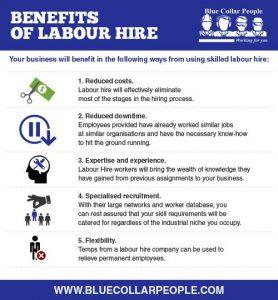In business, labour needs are always changing. A business may be overstaffed today and then become understaffed just a week later without any changes being made to the employee roster. There’re two common reasons why labour needs keep changing in companies.
These are:
– Worker absences. Your employees will sometimes miss work due to reasons such as illness, maternity and annual leaves. This creates labour shortfalls without the number of employees on your payroll changing.
– Fluctuating demand for your product. When demand is high, your production needs will increase making your current labour force inadequate for operations. A fall in demand for products, on the other hand, will result in reduced production and hence you’ll have a problem of excess employees.
Since permanent workers cannot be hired and let go on a very short time scale easily, temporary workers are hired to fill any short-term labour shortfalls that arise. And this is where labour hire comes in.
What is labour hire?
Labour hire is an arrangement in which a third party (known as a labour hire agency) provides your business with outsourced skilled and unskilled workers on a short term or long term arrangement. The workers often referred to as : “temps”, “on-hired employees” or “contractors” – are employed by the labour hire agency and are not your employees even though they work in your organisation.
In its infancy just a few decades ago, labour hire only provided workers for simple positions such as file clerks and secretaries. As it advanced and gained more popularity in the world of business, labour hire continued to add different skills to its catalogue making it what it is now: a one stop shop for all your labour needs.
It doesn’t matter what your company’s labour needs are, labour hire provides all sorts of skilled employees.
Although labour hire has become more popular as a way of smoothing demand for labour in organisations, most people still do not fully understand the immense benefits their businesses stand to gain by using labour hire. In this post, we’ll compare the cost of using labour hire with its benefits to see why using labour hire is a wise strategy.
Labour hire costs are almost the same as any other temporary hire your business would make. Sometimes there is a small variation in pricing, though, due to the extra services that are bundled with the employee provided to your organisation. The cost of using labour hire is, however, much lower compared to recruiting for temporary positions.
Labour hire rates are a bit higher than those of regular employees because they include insurance and other relevant employee entitlements and benefits that are not directly included in a regular employee’s pay cheque. These include:
- Worker compensation insurance. This provides a temporary income to employees who are injured in the workplace and as a result can’t work.
- Public liability insurance. This protects the employer from negligence suits as a result of an on-hired staff’s error that results in damaged property or injuries.
- Payroll tax.
- Superannuation – a mandatory entitlement for all employees.
- Relevant training and tickets.
- Personal protection workwear and equipment – where applicable.
Just as employees don’t get paid equal salaries, on-hired workers are also provided at varying rates. Some of the factors that determine the rate of an on-hired worker include:
- Education and training. Workers with more specialised skills and qualifications will cost more than those with limited or no skills.
- Market forces. The rates of labour hire are dependent on the prevailing market conditions and the going rate for the specified skillset.
- Location. Rates will also depend on the location of your business with prices going up with the increasing remoteness of your business operation.
Other factors could also affect labour hire rates depending on the needs of the client.
The benefits of labour hire
Some of these benefits include:
- Workforce flexibility. With labour hire you are able to make quick adjustments to your workforce to ensure that you are neither under or over staffed. You can quickly get employees to cover a gap without committing yourself to full employment. This means that you can reduce the number of employees just as easily, saving on costs of keeping idle employees on your payroll.
- Cost saving. Although labour hire may sometimes be expensive in the short-term, the savings you will make over time will be tremendous. Think of it this way; you will need to recruit new part-time employees every time you need some extra hands. This involves costs such as advertising, CV evaluation, interviewing, training and more. Do this a couple of times per year and the figures add up to something significant. With labour hire, recruitment and matters payroll are left to the agency.
- Additional expertise. Sometimes special projects might require skills that none of your current employees’ possesses. Because the position will only be there for the duration of the project, hiring a permanent employee would not be feasible. Labour hire allows you to get the expertise you need on a temporary basis without having to hire the employee permanently.
- Reduced training time. Training takes a lot of time and costs a lot of money too. When the employee is only employed by the company for a short time, this cost can be too much to justify. Labour hire gives you access to temporary employees who have already undergone training, saving you the trouble.
- Access to a larger talent pool. Labour hire will give your company access to a large talent pool where you can get someone to fill any position within a very short time.
- Paid entitlements. The cost of a labour hire worker supplied to you also includes their annual leave and sick leave entitlements
For businesses that require temporary employees from time to time, labour hire provides the best solution. It gives your business access to ready and willing employees with different skills who can cover labour gaps within a short time.
Ask Blue Collar people how we can help your business: (08) 9221 1911.







